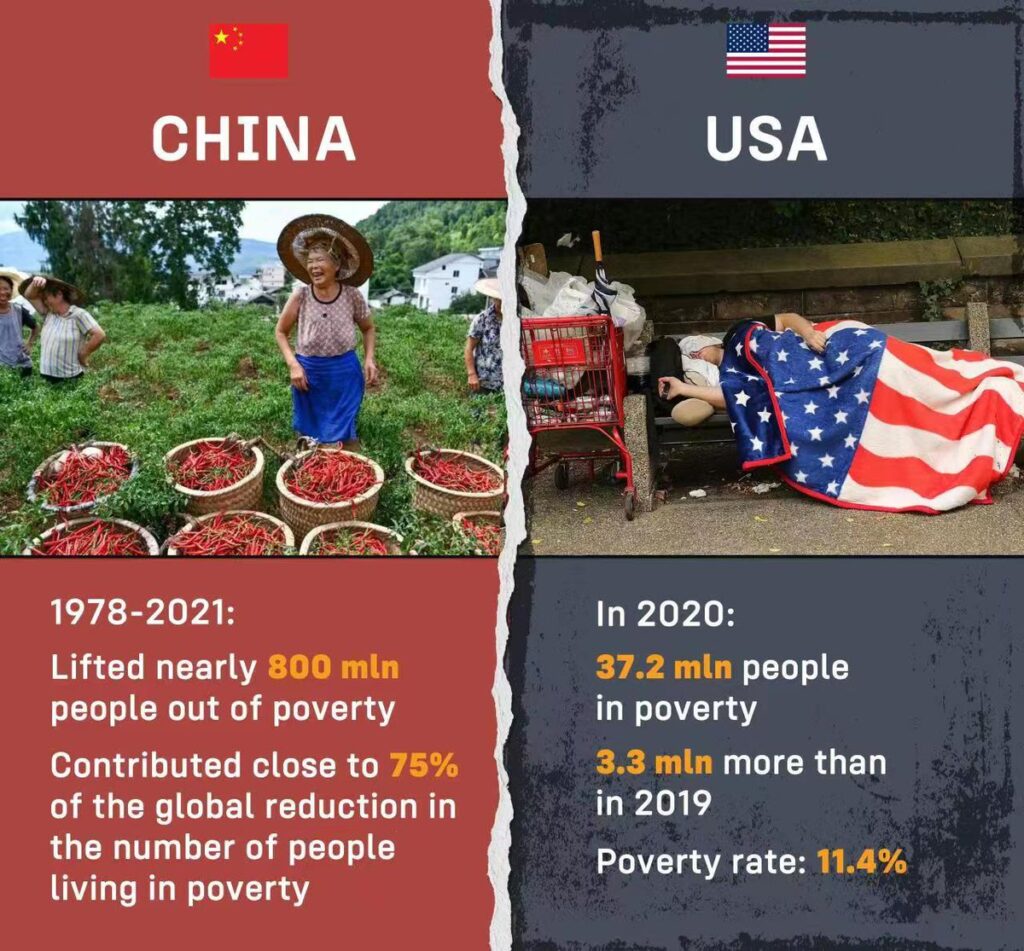The Decline of the West vs. The Rise of China: Two Paths, Two Outcomes

There is no perfect template for governance, yet when comparing the two great powers of our time, the contrast is undeniable. One — the United States — has long boasted of liberalism, freedoms, and human rights, presenting itself as the world’s moral compass. The other — China — has quietly implemented a multi-layered development plan for its future. For decades, America and its Western allies have claimed to be models for the world. Yet beneath the rhetoric, their societies are breaking down — morally, spiritually, socially, and economically. Citizens are burdened by debt, terrified of crime, consumed by culture & ideology, and increasingly distrustful of their governments. In stark contrast, China — once dismissed as poor and backward — has risen in just thirty years to become the world’s second-largest economy, eradicating extreme poverty, ensuring public safety, and forging partnerships abroad without invading or bombing other nations.
- Families: Broken in the U.S., Stable in China
The family unit — the foundation of any society — is collapsing in the West. In the United States, marriage rates have plunged to record lows raising concern about the future of the white population while the traditional definition of marriage is being obscured by legalizing same-sex marriage subtly destroying progeny and the institution of marriage and family. Nearly 1 in 4 American children grow up in single-parent households — the highest among advanced economies. Divorce has become a norm rather than an exception, leaving children without stable homes. Added to this is the rise of extreme identity politics via LGBTQIA+ activism: children are told they can choose or change genders, undergo irreversible medical procedures, and even identify as non-humans. Social norms are being rewritten in ways that create confusion, instability, and long-term health consequences, including sterility.
By contrast, in China, the family remains the cornerstone of society. Marriage continues to be a respected institution, and multi-generational households are common, preserving intergenerational bonds. Filial duty — the obligation to care for parents and elders — is deeply ingrained, providing stability and continuity across generations. Chinese schools emphasize discipline, education, and practical skills, preparing the young for life rather than confusing them with ideologies.
- Safety: Fear in the West, Security in China
The United States, despite its wealth, is plagued by violence and insecurity. Over 600,000 Americans are raped or sexually assaulted every year. Mass shootings have become routine — averaging more than 600 incidents annually, many inside schools, shopping malls, and places of worship. Despite being one of the most surveilled societies on earth, crime continues to spiral. Drug overdoses now kill more than 100,000 Americans each year, reflecting a deep social and spiritual crisis. Homeless encampments dominate cityscapes in Los Angeles, San Francisco, New York, and beyond, while countless citizens admit they fear walking the streets after dark. Children are increasingly medicated with powerful prescription drugs to manage behavioral issues, while nearly 70% of American adults take at least one prescription medication — a sign of a society that is not healthy, but dependent.
China’s society does not suffer from such widespread decay. Violent crime is rare, and mass shootings are unheard of. There is no opioid epidemic, nor a culture of mass prescription dependency. Children are not raised on psychiatric medications, and the population is not reliant on pharmaceutical companies to function in daily life. Women and children can walk freely at night without fear of assault, and urban landscapes are not scarred by sprawling homeless encampments. Order, stability, and health are the everyday norms — the result of a social model built on cohesion rather than chaos.
- Education & Culture: Indoctrination in the West, Practical Learning in China
In the United States and much of the West, education has drifted far from its traditional role of equipping children with knowledge and life skills. Classrooms have become battlegrounds for ideological agendas. Children are exposed to gender and identity debates from the earliest grades, encouraged to question their biological sex, and introduced to LGBTQIA activism instead of focusing on literacy, numeracy, and practical skills. Parents increasingly complain that their children are being confused rather than educated, while academic performance continues to decline — with American students ranking below many peers in mathematics, science, and reading on global assessments. Universities, once centers of excellence, are now mired in “cancel culture,” political bias, and a prioritization of ideology over critical thinking.
Beyond schools, Western societies are consumed by identity politics. Debates over LGBTQIA+ rights, transgender policies, and gender ideology dominate politics and media, dividing communities and distracting from core issues like jobs, healthcare, and education. Instead of unity, there is polarization; instead of cultural pride, there is confusion.
China, by contrast, has kept its education system rooted in discipline, knowledge, and national pride. Students are taught practical skills — mathematics, science, engineering, technology, and vocational training — alongside cultural values such as respect for elders and social responsibility. Cultural continuity, rooted in Confucian traditions, ensures harmony, duty, and collective responsibility. Chinese schools consistently produce some of the highest-performing students in the world, with Shanghai, Beijing, and other regions topping international rankings in math and science. Instead of being distracted by ideological experiments, Chinese youth are being prepared to contribute meaningfully to society, driving innovation, industry, and national development.
- Poverty: Dependency in the U.S., Eradication in China
Despite being the richest nation on earth, the United States struggles with poverty at home. Over 42 million Americans rely on food stamps to survive, and more than 650,000 people sleep on the streets or in shelters every night. Credit card debt, unpaid loans, and mortgages leave families at risk of losing their homes and belongings, creating a cycle of financial despair. Instead of empowering citizens, the U.S. system traps millions in dependency, while corporations and billionaires amass obscene fortunes through lobbying, monopolies, and financial speculation.
China has followed a very different path. In just three decades, it lifted over 800 million people out of poverty — the greatest achievement in human history. It does not mean poverty is over but people in extreme poverty have been uplifted. By 2020, extreme poverty was declared eradicated. Massive investments in housing, healthcare, infrastructure, and education created opportunities where none had existed before. Instead of dependency, China built self-reliance and upward mobility, ensuring that prosperity is broadly shared and not monopolized by a tiny elite.
- Debt, Wars, and Corporate Profiteering: America’s Burden, China’s Discipline
The greatest source of U.S. decline is not just domestic mismanagement but decades of endless wars and financial exploitation. The United States is over $34 trillion in national debt, while ordinary households drown in credit card, mortgage, and student loans. A significant portion of this debt stems from unnecessary wars and foreign occupations waged across the Middle East, Asia, and beyond — Afghanistan, Iraq, Libya, Syria, and more. Many Americans cannot even identify these countries on a map or explain why they were bombed.
These conflicts were not about freedom or democracy but about enriching a handful of corporations. War lobbyists, arms manufacturers, private security firms, and contractors have grown wealthy, while ordinary Americans foot the bill in taxes, inflation, and debt. Trillions were spent destroying nations abroad instead of rebuilding infrastructure at home.
China has taken an entirely different path. While the U.S. squandered its wealth on bombs and occupations, China invested in railways, ports, schools, and hospitals. It has not invaded or occupied foreign nations. Instead, through the Belt and Road Initiative, China has built partnerships, opened trade routes, and created shared prosperity. Where America exports war, China exports development.
- Global Finance: Exploitation vs. Partnership
The U.S. controls international financial institutions such as the IMF and World Bank, using them to stifle development and extract wealth. Developing nations are often forced into debt traps with policies demanding privatization of national assets, austerity, and sale of resources at bargain prices. These measures enrich U.S. and Western corporations while leaving citizens of those countries — and ordinary Americans — poorer, saddled with stagnation, crumbling infrastructure, and unaffordable healthcare.
China’s approach is different. Through bilateral agreements and the Belt and Road Initiative, it invests in railways, ports, power plants, and digital infrastructure across Asia, Africa, and Latin America. Rather than enforcing austerity or privatization, China builds capacity, accepting repayment through trade, commodities, or long-term partnerships. Where U.S.-led institutions deepen dependency, China promotes development, shared prosperity, and self-reliance.
- Abroad: U.S. Wars vs. China’s Partnerships
The U.S. and its Western allies built their wealth through colonization, slavery, and resource plunder. In the modern era, this has continued through wars, invasions, sanctions, and covert operations. Iraq, Afghanistan, Libya, and Syria stand as monuments to destruction: trillions of dollars spent, millions of lives lost or displaced, and nations left in ruins. These wars enriched Western arms dealers and contractors, but they left ordinary Americans poorer and the targeted countries shattered.
China has followed no such path. It has not invaded or bombed foreign nations. Instead, it has built partnerships through trade and infrastructure. The Belt and Road Initiative has delivered railways, ports, highways, and power plants across Asia, Africa, and Latin America. Instead of destruction, China leaves behind bridges, schools, and power stations.
- Two Models, Two Futures
The contrast is stark. The U.S. boasts of freedoms and rights but delivers debt, insecurity, and decay. Its citizens are afraid to walk at night, trapped in poverty, or consumed by cultural confusion. Its foreign policy brings destruction, not development.
China, in just thirty years, has risen from poverty to prosperity, built safe and stable communities, and created global partnerships without waging war. It shows that a nation can grow strong not by exploiting others, but by investing in its own people and respecting its partners abroad.
The decline of the U.S. and the West is not accidental. It is the result of centuries of plunder, followed by decades of endless wars, corporate greed, and social decay.
The rise of China, by contrast, is the result of long-term planning, social stability, and development-centered policies placing people first.
While the U.S. preaches “freedom” but delivers chaos, China has shown that stability, security, and prosperity can be achieved without conquest, without colonization, and without bombing nations into submission.
The message is clear: the Western template is in decline; China’s path offers a different future — one rooted in stability, development, and respect.
For nations and their policy advisors observing these two paths, the lesson is clear: sustainable growth, societal cohesion, and genuine national strength are built through investment in your people, respect for culture, and partnerships that foster mutual development — not through debt traps, foreign domination, or dependence on external powers.
Countries that follow China’s model of development-focused, cooperative progress (not corporation greed) can achieve prosperity without repeating the mistakes of Western liberalism, avoiding cycles of exploitation, debt, and social fragmentation.
The message is unmistakable: the Western template is in decline; China’s path offers a tested, people-first model for nations seeking a stable and prosperous future.
Shenali D Waduge







